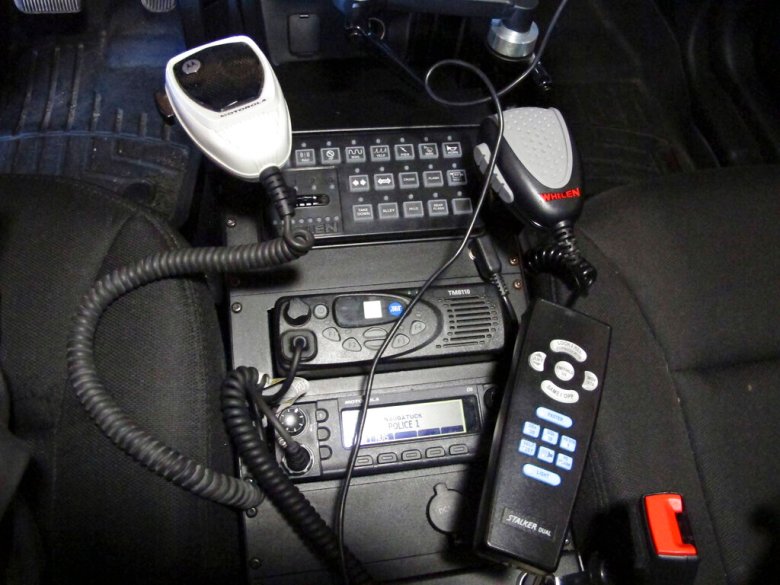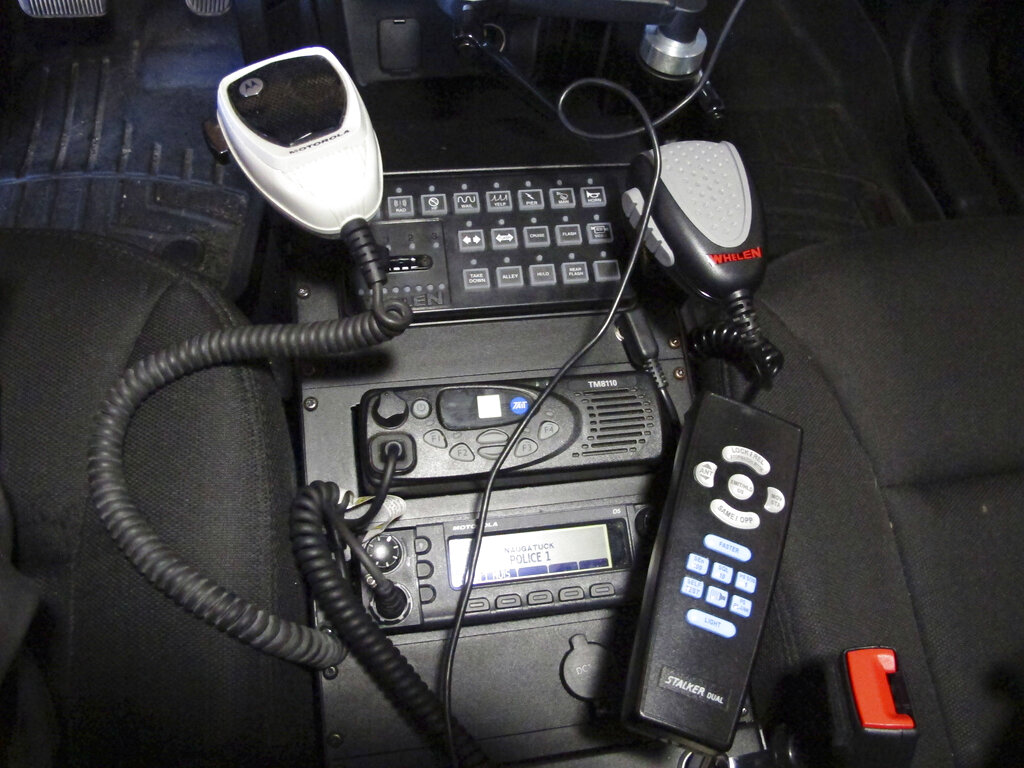 A radio in a police cruiser. The Berkeley City Council will vote Tuesday on whether to silence all scanner traffic to the public. Credit: AP/Dave Collins
A radio in a police cruiser. The Berkeley City Council will vote Tuesday on whether to silence all scanner traffic to the public. Credit: AP/Dave Collins
For decades, the Berkeley Police Department’s radio communications were open for anyone to listen to.
All that was required was a piece of off-the-shelf radio equipment, a scanner. And for years, the popular website Broadcastify.com livestreamed BPD’s radio transmissions (and hundreds of other public safety agency feeds), and offered an archive of recordings.
Tuning in, the public could listen in real time as officers and dispatchers handled welfare checks, shootings, car crashes, missing persons, downed power lines, robberies — any incident called into 911.
Listening to police scanners has been a staple of newsroom activity since police radios were invented. Reporters tune in to get a sense of how their city’s police department is operating or to cover emergencies like fires, earthquakes, or mass shootings and major events like protests and parades.
That’s why many journalists are concerned about recent decisions to encrypt radio communications.
Over the past several weeks, every police agency in Alameda County other than Berkeley has moved to encrypt their radio communications.
Berkeley had previously adopted a policy stating that public safety transmissions should be kept open to the public “in accordance with the First Amendment and in spirit of transparency,” and it seemed likely the city would be the county’s lone holdout. As recently as last month, a Berkeley police lieutenant said at a public meeting that the department had no plans to hide its radio chatter.
But Police Chief Jen Louis has reversed course and asked the City Council for permission to silence all radio calls. The proposal will go before the council on Tuesday, where it is listed on the consent agenda.
Why do Berkeley police want to encrypt their radios?
In 2020, Xavier Becerra, then California’s attorney general, issued a memo to police departments telling them they needed to take steps to make sure that sensitive information drawn from law enforcement databases, as well as personal information about crime victims, suspects, and others, wasn’t broadcast over police radios.
Some departments like the California Highway Patrol and Palo Alto police responded by keeping their dispatch and patrol channels open to the public while directing officers to use special encrypted channels, or cell phones, to relay sensitive information. Many police calls in Berkeley already are over encrypted bands — such as Special Response Team calls, special patrol and investigative calls.
Other departments like San Jose and agencies in Contra Costa County decided to encrypt everything.
Berkeley police say a shortage of dispatchers means the encrypted bands meant for sensitive conversations are often offline, though press advocates argue the solution is increased staffing and tighter enforcement of rules about when to use secure channels.
Louis also told the City Council that encrypting radio chatter is needed to keep officers safe and that burglars have been caught listening in on open channels, which can give them real-time information on where some officers are heading. (She did not respond to Berkleyside’s request last week to share details of incidents when a scanner was used to abet a crime.)
BPD also says it worries that with other agencies in the county ending their encryption, scanner-savvy criminals could soon target Berkeley.
Berkeley police promise to maintain transparency through social media posts, media briefing and fulfilling Public Records Act requests.
How will this impact local reporting?
Berkeley police’s radio encryption would make it far more difficult to report breaking news stories in real time. Reporters would have one fewer tool to dissect what happened during a crisis, unfiltered by the department’s public information officers.
At Berkeleyside and our sister sites in Oakland and Richmond, we’ve relied many times on our ability to access public safety agency radio communications. The scanner has helped us report on attacks on the police, police shootings, standoffs, sideshows, burglaries, high-speed chases and fires.
While Berkeleyside does not directly quote or paraphrase police radio chatter, access to BPD’s dispatch channels is crucial to knowing where and when news is happening — hearing a critical call on the scanner is often the first tip we receive that a major breaking story is underway. It can be helpful in sorting fact from fiction in confusing, fast-moving situations, such as reports of active shooters.
During the George Floyd protests in 2020, we were in the streets reporting, but we also listened to the scanner to keep track of the marches and rallies and see how the police were responding.
Police radio was also a key source in helping our colleagues at The Oaklandside do initial reporting on the police shooting of Erik Salgado and Brianna Colombo. Salgado was killed and Colombo wounded after Salgado tried to drive the car the two were in through a California Highway Patrol blockade. Salgado’s family sued the CHP and the agency later settled the case for $7 million.
Whenever a big fire breaks out, our newsroom turns up the volume on the scanner feed. The fire department has its own radio system, which we also monitor, but during fires, chatter on the police scanner can be critical.
Recordings of police radio transmissions are public records, subject to disclosure to anyone who requests them. But Berkeley’s communications and records offices are short-staffed, slow to respond to requests, sometimes fail to provide records relevant to the original request, and often make use of exemptions that allow public agencies to withhold records and information.
Berkeleyside staff contributed reporting to this story.
“*” indicates required fields

